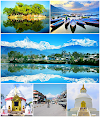 |
| Pasupatinath Temple |
Committed to Lord Shiva, Pashupatinath is one of the four most significant strict locales in Asia for fans of Shiva. Underlying the fifth century and later revamped by Malla lords, the actual site is said to have existed from the start of the thousand years when a Shiva lingam was found here.
The biggest sanctuary complex in Nepal, it extends on the two sides of the Bagmati River which is viewed as sacred by Hindus. The principle pagoda style sanctuary has an overlaid rooftop, four sides canvassed in silver, and choice wood carvings. Sanctuaries committed to a few other Hindu and Buddhist gods encompass the sanctuary of Pashupatinath.
 |
| Baba smoking Weed |
Incineration of Hindus occur on raised stages along the stream. Just Hindus are permitted through the entryways of the primary sanctuary. The inward sanctum has a Shiva lingam and confronting the sanctuary sits the biggest sculpture of Nandi the bull, the vehicle of Shiva. There are many Shiva lingamswithin the compound. The enormous Maha Shivaratri celebration in spring draws in countless lovers from inside Nepal and from India. Further east before the Bagmati arrives at Pashupati is the sanctuary of Guheshwori devoted to Shiva's associate Sati Devi.
 |
| Pasupatinath Temple |
Visit Pashupatinath for an unparalleled blend of strict, social and otherworldly encounters. Found 3 km northwest of Kathmandu on the banks of the Bagmati River, the sanctuary region additionally incorporates Deupatan, Jaya Bageshori, Gaurighat (Holy Bath), Kutumbahal, Gaushala, Pingalasthan and Sleshmantak backwoods. There are around 492 sanctuaries, 15 Shivalayas (holy places of Lord Shiva) and 12 Jyoirlinga (phallic altars) to investigate.
 |
| Baba of Pasupatinath temple |
Pashupatinath Temple is one of the seven UNESCO Cultural Heritage Sites of the Kathmandu Valley. It is likewise an incineration site where the last customs of Hindus are performed. The ceremonies of incineration isn't for the cowardly; still guests are seen observing inquisitively from across the waterway from the slope. Visit Pashupatinath Temple for an awesome encounter.
Every day Rituals at Pashupatinath Temple
Pashupatinath is additionally one of only a handful few living social legacy destinations on the planet. In contrast to other social destinations or exhibition halls, Pashupatinath is the focal point of energy with dynamic cooperation of individuals consistently of the day, consistently. The day by day ceremonies of Pashupatinath Temple are as per the following:
* 4:00 am: West entryway opens for guests.
* 8:30 am: After appearance of Pujaris, the symbols of the Lord are washed and cleaned, garments and gems are changed for the afternoon.
*9:30 am: Baal Bhog or breakfast is offered to the Lord.
*10:00 am: Then individuals who need to do Puja are invited to do as such. It is likewise called Farmayishi Puja, whereby individuals advise the Pujari to do an uncommon Puja for explicit reasons. The Puja proceeds till 1:45 pm in the early evening.
*1:50 pm: Lunch is offered to the Lord in the primary Pashupati Temple.
*2:00 pm: Morning supplications end.
*5:15 pm: The night Aarati at the fundamental Pashupati Temple starts.
*6:00 pm ahead: lately the Bagmati Ganga Aarati that is finished by the banks of the Bagmati has been acquiring prevalence. There are bigger groups going to on Saturdays, Mondays and on exceptional events. Ganga Aarati alongside Shiva's Tandava Bhajan, composed by Ravana, is completed during the night Ganga Aarati.
*7:00 pm: Doors close.
Aside from the every day customs, exceptional noticed are plotted during uncommon dates of the lunar schedule.
bestsplacesinnepal
Thanks for reading...




0 Comments
darnalnirbikram@gmail.com